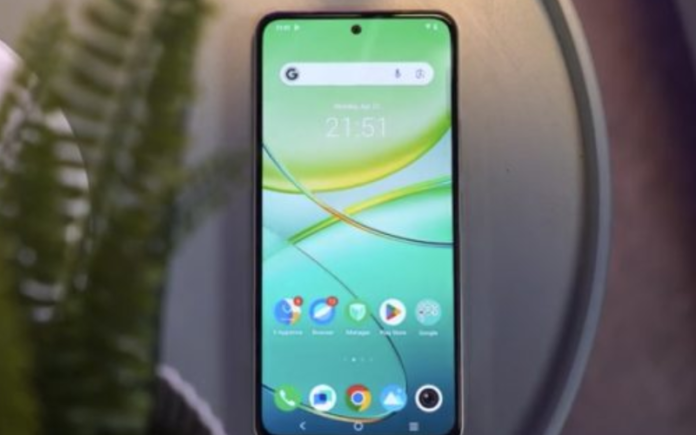The budget midrange smartphone market keeps heating up every year. In 2024, there are tons of great phone options under NRP 30,000, with many packing solid specs and performance.
Today, we’re checking out a fresh face in this crowded scene – the vivo V30 Lite. It looks good and is easy on the wallet, starting at just NRP 29,500 for the 8GB+256GB version. Of course, some trade-offs exist, especially when you line it up against its rivals.
So, here is the Vivo V30 Lite Full Review to answer how the new vivo V30 Lite measures up to the competition.
Table of Contents
Vivo V30 Lite Full Review: Detailed Analysis, Pros and Cons
Design and Build
Talking about the feeling when you hold the phone first, it’s impressive, especially in the Crystal Black color of the review unit we have. The phone is easy to hold and lightweight. The matte finish on the back helps resist smudges, though the glossy finish on the camera island isn’t as resistant. You might want to use the phone without a case to show off its nice back design.
Initially, we thought the back panel was made of plastic like the frame. However, Vivo says the color-changing effect is due to Color Changing Fluorite AG Glass, so it is made of glass. It seems quite scratch-resistant too, as it held up well without a case and was carried in my bag with other items.

The phone isn’t the slimmest or lightest on the market, measuring 163.17 × 75.81 × 7.95 mm and weighing 196g. Overall, it feels sturdy and is easy to use with one hand. The volume rocker and power button are on the right side, while the left side is clean. At the bottom, there’s a USB-C port, a loudspeaker, and slots for dual SIM cards and a microSD card. The top only has a secondary microphone, and the earpiece doubles as a loudspeaker.
The vivo V30 Lite comes with stereo speakers and has an IP54 rating for dust and splash resistance.
Display
One of my favorite things about the Vivo V30 Lite is its display. It features a 6.67-inch AMOLED screen with a resolution of 2400 × 1080 and a 120Hz refresh rate. The borders are fairly thin, although the top and bottom are slightly thicker, but it’s not noticeable.
As expected from an AMOLED display, the colors are vivid and the blacks are deep, making for a great viewing experience. In the settings, you can adjust the screen colors to your preference: Standard (default), Pro (which desaturates the colors), and Bright (for more vibrant colors). You can also customize the screen color temperature to your liking.

The 120Hz refresh rate ensures smooth animations, whether you’re watching videos or browsing social media. Gamers, in particular, will appreciate the 120Hz refresh rate, but we’ll talk more about gaming performance later.
What surprised me was how bright the screen got. The vivo V30 Lite has a maximum brightness of 1800 nits, which is exceptionally bright for its class. For comparison, most phones in this price range usually have a peak brightness of around 950-1200 nits.
Using it on hot summer days, I found the screen to be very bright. I could easily see everything on the screen even when I was outside around 1 PM. This is great if you plan to be outdoors a lot, whether you need to reply to emails or just want to relax outside.
The speakers are impressive too. They’re Hi-Res certified and the dual stereo speakers are very loud, reaching up to 300% volume when watching videos. The audio output is clear with a decent sound stage. However, when you increase the volume to 200% or higher, the audio quality drops in favor of loudness.
Camera
The vivo V30 Lite has a dual rear camera setup, with a main 50MP shooter, a 2MP depth sensor, and a flicker sensor. For selfies, there’s an 8MP front camera.
The photo quality isn’t the best. You’ll get decent, sharp images with good contrast in well-lit conditions. But if you zoom in, the clarity isn’t great. Photos lose detail and sharpness at night or in low light, looking somewhat smoothed out to reduce grain.


If you’re not too picky about photos, they’re okay. However, editing them afterward with Lightroom Mobile or another editing app can make them look better.


The videos are similar. The Y100 records at a maximum of 1080P@30FPS. They’re decent for recording content, but there’s no image stabilization, so you’ll need a steady hand to avoid shaky videos. Overall, they’re okay for casual content creation.


Performance
So far, the vivo V30 Lite has impressed with its design, display, and audio quality. While the camera could be better, it’s still quite decent and usable. However, one area where the Y100 falls short is its chipset.
The vivo V30 Lite is powered by a Snapdragon 685 4G chipset, along with 8GB of RAM and up to 256GB of internal storage. If you need more storage, there’s a microSD card slot for expansion. The Snapdragon 685 isn’t the most powerful chipset, and this is noticeable. For tasks like replying to emails, browsing social media, and watching videos, it performs adequately. However, its limitations become apparent when playing games. To give you a better idea of the phone’s performance, here are the benchmark scores.


From my experience, the Y100 handles light games like Mobile Legends and Asphalt 9 without any issues. However, it struggles with more graphic-intensive titles. For instance, Genshin Impact can run on low settings, but you’ll encounter framerate drops and stutters, especially during intense scenes. Setting the game to max graphics and 60FPS is not advisable.
There is a Game Booster feature that aims to improve performance, but it didn’t help much with Genshin Impact. Additionally, the phone heats up quickly after about 30 minutes of gameplay.

So, while you can play games on the vivo V30 Lite, it’s not ideal for graphic-intensive titles like Genshin Impact. Lighter games should run fine, though.
OS and UI
The vivo V30 Lite runs on Android 14 with Funtouch 14. Funtouch 14 is user-friendly and offers several handy features, such as a hidden taskbar on the side for quick app access. There are also various customization options to give users a personal touch. You can change themes, adjust graphics, and even modify the charging animations in the settings.
One of the most useful features vivo added to this phone relates to battery life. We will discuss these in more detail in the battery section. For now, know that you can choose whether you want fast charging all the time and find ways to efficiently save battery life.

However, one downside of the vivo V30 Lite is the amount of bloatware it comes with. Many pre-installed apps take up valuable space, and I ended up deleting most of them.
Battery and Charging
The battery life of the vivo V30 Lite is really good. Even though it only has a 5,000 mAh battery, it lasts a long time. During my time using the phone, it lasted more than a day, even when I was using it to take photos, watch videos, and play games.
Playing Genshin Impact seemed to drain the battery faster because the phone heated up. But once I stopped playing, the phone cooled down and became efficient again.
Some features help save battery life. In battery saver mode, you can adjust settings to save power. When the battery is low, you can activate Super Battery Saving Mode to make it last longer. When you need to charge the phone, it supports 80W wired fast charging.
In terms of connectivity, the phone only supports 4G. But it has other features like dual-band Wi-Fi, Bluetooth 5.0, GPS, and NFC.
Pros and Cons
| Pros | Cons |
| Nice design | Only 4G connectivity |
| Beautiful Display | Lackluster camera |
| Great Audio | Performance could be better |
| Very long battery life |
Verdict
In summary, the vivo V30 Lite has its good points and not-so-good points. Starting at PHP 12,499 for the 8GB+128GB model, it’s a budget-friendly option for people who prioritize style, a beautiful display, good audio, and long battery life.
However, it falls short when it comes to gaming performance, lacks 5G connectivity, and has a mediocre camera. In a competitive market, the Y100 might struggle to attract buyers compared to other options available.
But if you don’t need high performance, it could still be a good choice for you.







